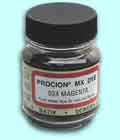Advertisements
Procion MX Fiber Reactive Dye:
Turquoise
Procion MX
Lemon Yellow Dye
Procion MX
Magenta Dye

Advertisements

Procion MX type dyes can be mixed to achieve any hue you can imagine. It is best to start with only single-hue unmixed dyes as your mixing primaries, because premixed colors can have unexpected resutls, depending on the different propterties of the dyes in them. See the charts on my page Which Procion MX colors are pure, and which mixtures? for the various specific names use for the different mixing primaries available from the major dye suppliers.
See the Procion MX section at the top of my page What colors should I buy to start out with?. You will need, at minimum, yellow MX-8G, turquoise MX-G, and red MX-8B, plus a premixed black such as black MX-CWNA. For intermediate dye mixing, you should, in addition, get yellow MX-GR, orange MX-2R, blue MX-R, blue MX-G, and either blue MX-2G or navy blue MX-3R. I also recommend yellow MX-3R or 3RA, brown MX-GRN, red MX-5B, magenta MX-B (ProChem's boysenberry), and violet MX-2R.
I have copies of three sets of color mixing charts here on this site:
The Jacquard Products chart has the drawback (or advantage) of using volume measurements, such as teaspoons, instead of weight, such as grams. Color mixing is far more hit-or-miss when you measure by volume, because different lots of dye will be more or less dense than previous dyelots. Measuring with a teaspoon is faster and easier, but measuring by weight with a proper scale gives far more reproducible results. The other two charts are based on grams rather than teaspoons.
The Jacquard Products and the Maiwa Handprints charts both call for some of their premixed colors in addition to the unmixed Procion MX mixing primaries. Neither shows color swatches for the colors produced; use the color names as your guide.
The Dreamline scheme, shown with swatches suggesting possible color outcomes, is based on two sets of three colors. The first, for bright colors, uses yellow MX-8G, red MX-5B, and (I think) turquoise MX-G; the second, for deeper colors, uses yellow MX-3R, red MX-B (I'm not 100% certain which dye they mean), and navy MX-3R.
An excellent way to preview what different colors you can mix to make another color is Olli Niemitalo's wonderful Dye Mixer Applet, at http://iki.fi/o/dye/dyemixer/. It's a great way to experiment with dye color mixing, but unfortunately it has not been calibrated for how much dye is required to get each color. If you wish to use it to specify exactly how many grams of each dye you should mix, you will have to create your own swatches with each of the pure unmixed colors you are using as your mixing primaries. The Dye Mixer Applet does not include some of the Procion MX mixing primaries, and it does include some premixed colors.
After trying all of the above color mixing guidelines that interest you, you are going to have to do some dyeing to find how you prefer to mix your colors. There are hundreds of thousands of possibilities provided by the twenty or so single-hue unmixed dyes in the Procion MX line. Complicating things further, you can also mix Procion MX dyes with other fiber reactive dyes, such as the Cibacron F dyes.
A wonderful place to discuss mixing colors is the Dye Forum on this website. Anyone interested in dyeing can join the forum, at no charge; you must reply to the welcome email that arrives, after you register, before you can gain full access, solely in order to distinguish dyers (and those interested in dyeing) from the robospammers that otherwise afflict all online forums these days.
If you have the opportunity, consider taking one of Carol Soderlund's workshops on 'Color Mixing for Dyers'. Of course, it is not necessary to take a class in order to learn to mix colors. Trial and error will serve you very well, as long as you keep careful records.
 See
answers to more questions about dyes and dyeing
See
answers to more questions about dyes and dyeing
Last updated: July 25, 2014
Page created: November 17, 2008
Downloaded: Wednesday, December 17, 2025
All of the pages on this site are copyright ©1998-2025 Paula E. Burch, Ph.D.